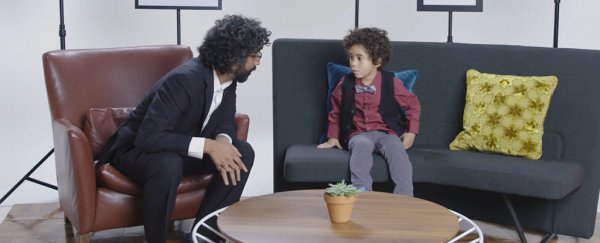If there's an award for being able to explain complex science in a simple way, no matter who's in the audience, our nomination would be for Bobby Kasthuri from the Argonne National Laboratory in Illinois.
In the video below, he explains the difficult concept of connectomes – a map of neural connections in the brain – to five different people: a five-year-old, a 13-year-old, a college student, a neuroscience grad student, and a connectome entrepreneur.
And he nails it each time.
"There's way more cells in your brain than all the stars we can see," he begins to five-year-old Daniel Dodson. "We'd like to know where every cell in your brain is."
And with Brain Backups founder Russell Hanson – who knows a little bit more about connectomics – he discusses the neural substrates or layers of human memory rather than stars and cells:
Other than maybe teaching you something you didn't know about connectomes, it's pretty much a masterclass in tailoring your message and explaining something in a way your audience is going to understand.
As the video explains in five different ways, a connectome is a very detailed map of the cells inside our brains - where they are and how they connect together - though with so many cells involved, actually making the map isn't going to be simple at all.
Scientists want to map the connectome to understand more about how the brain functions, as well as to improve our knowledge of brain diseases and how to stop them.
Seriously though, don't take our word for it 0 watch the video above and let Bobby Kasthuri lay it all out for you.
He tells 13-year-old Jabez Griggs about the neuron wiring inside the brain and the basics of how cells use electricity to communicate with each other.
And with college student Elena Dowling, Kasthuri discusses telectron microscopes and the scanning techniques being developed to try and map the brain at such a small scale.
Neuroscience grad student Mala Ananth already knows what a connectome is, so Kasthuri talks to her about whether or not such a map could accurately mimic a human brain inside a computer. In short, could we reproduce consciousness inside a program?
That's one of the big questions scientists and philosophers are grappling with, but we're still a long way from knowing the answer.
Many more years of research and investment will be required before we can figure out how to map and develop accurate algorithms for mice brains - and then it's another huge jump to the human brain, which contains somewhere in the region of two exabytes of storage (that's close to 8 million 256GB iPhones from Apple).
But even if mapping the connectome remains an incredibly complex challenge, at least now we all know what we're talking about 0 and even Kasthuri learned something.
"I'm impressed that when you talk to people about something that seems kind of crazy and outlandish, and perhaps [something] they hadn't been talking about before, it doesn't take them long to come a kind of considered opinion," he says.
